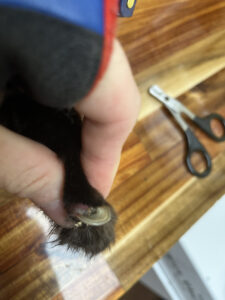When cat claws become ingrown, it means that the claw has grown into the pad of the cat’s paw instead of growing outward.
This can be a painful and uncomfortable condition for the cat. There are several reasons why cat claws can become ingrown.
One common cause is improper trimming of the claws. When a cat’s claws are not trimmed regularly or are trimmed incorrectly, it can cause the claws to become ingrown. The claws may grow too long and curl into the pad, or they may be cut too short and cause the pad to grow over the claw.
Another cause of ingrown claws is trauma or injury to the paw.
If a cat injures its paw, such as by catching it on something or landing awkwardly, it can cause the claw to become ingrown. In some cases, the trauma may lead to the growth of abnormal tissue around the claw, exacerbating the ingrown condition.
Certain breeds of cats are more prone to ingrown claws. For example, cats with extra toes, such as polydactyl cats, may have a higher risk of developing ingrown claws. This is because the extra toes can create an environment where the claws are more likely to grow inwards instead of outward.
To prevent ingrown claws, it is important to trim a cat’s claws regularly and correctly.
This involves using proper cat nail clippers and being careful not to cut the claws too short. If you are unsure how to trim your cat’s claws, it is best to consult a veterinarian or a professional groomer for guidance.
If a cat already has ingrown claws, it is important to seek veterinary attention. A veterinarian can assess the severity of the condition and determine the best course of treatment. In some cases, the ingrown claw may need to be surgically removed under anesthesia. The veterinarian may also prescribe pain medication or antibiotics to help with any discomfort or infection.
Ingrown claws in cats can be caused by improper trimming, trauma, or certain breeds. Regular and correct claw trimming, as well as prompt veterinary attention for ingrown claws, can help prevent and treat this painful condition for our feline friends.



